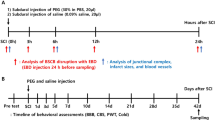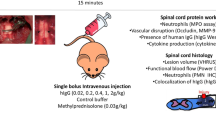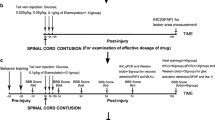Abstract
Injury to the spinal cord results in disruption of neurons, cell membranes, axons, myelin, and endothelial cells. The aim of this study was to demonstrate the protective effect of magnesium sulfate on the blood-spinal cord barrier after acute spinal cord injury (SCI). This experiment was conducted in two parts. In the first, rats were injected intravenously with Evans blue 2 h after SCI. The laminectomy-only group had no trauma. Contusion injury (50 g-cm) was applied to the trauma and treatment groups. Magnesium sulfate (600 mg/kg) was given to the treatment group immediately after injury. For the second part, clinical evaluations were performed 24 h post surgery. Then, following Evans blue injection, spinal cord samples were obtained from the laminectomy-only, trauma, and treatment groups. For the control group, nontraumatized spinal cord samples were taken after Evans blue injection following clinical examination. Laminectomy did not affect the spinal cord Evans blue content in 2-h and 24-h groups. The trauma increased tissue Evans blue content, and 24-h samples showed more remarkable tissue Evans blue content, suggesting secondary injury. Application of 600 mg/kg of magnesium resulted in lower Evans blue content in the spinal cord than with injury. Remarkable clinical neuroprotection was observed in the treatment groups. Magnesium sulfate showed vaso- and neuroprotective properties after contusion injury to the rat spinal cord. The authors also demonstrated secondary injury of the blood-spinal cord barrier with the Evans blue clearance technique for the first time.

Similar content being viewed by others
References
Dumont RJ, Okonkwo DO, Verma S, Hurlbert RJ, Boulos PT, Ellegala DB, Dumont AS (2001) Acute spinal cord injury, part I: pathophysiologic mechanisms. Clin Neuropharmacol 24:254–264
Mautes AEM, Weinzierl MR, Donovan F, Noble LJ (2000) Vascular events after spinal cord injury. Phys Ther 80:673–687
Tator CH, Fehlings MG (1991) Review of the secondary injury theory of acute spinal cord trauma with emphasis on vascular mechanisms. J Neurosurg 75:15–26
Hall ED, Wolf DL (1986) A pharmacological analysis of the pathophysiological mechanisms of posttraumatic spinal cord ischemia. J Neurosurg 64:951–961
Anthes DL, Theriault E, Tator CH (1996) Ultrastructural evidence for arterial vasospasm after spinal cord trauma. Neurosurgery 39:804–814
Schlosshauer B (1993) The blood-brain barrier: morphology, molecules, and neurothelin. Bioassay 15:341–346
Heat DL, Vink R (1999) Optimization of magnesium therapy after severe diffuse axonal injury in rats. J Pharmacol Exper Ther 288:1311–1316
Lang-Lazdunski L, Hearteaux C, Dupont H, Widmann C, Lazdunski M (2000) Prevention of ischemic spinal cord injury: comparative effects of magnesium sulphate and riluzole. J Vasc Surg 32:179–189
Robertson CS, Foltz R, Grossman G, Goodman JC (1986) Protection against experimental ischemic spinal cord injury. J Neurosurg 64:633–642
Simpson JA, Eide TR, Schiff GA, Clagnaz JF, Hossain I, Tverskoy A, Koski G (1994) Intrathecal magnesium sulphate protects the spinal cord from ischemic injury during aortic cross-clamping. Anesthesiology 81:1493–1499
Ustun ME, Gurbilek M, Ak A, Vatansev H, Duman A (2001) Effects of magnesium sulphate on tissue lactate and malondialdehyde levels in experimental head trauma. Intensive Care Med 27:264–268
Muir KW, Less KR (1995) A randomized, double blind, placebo controlled pilot trial of intravenous magnesium sulphate in acute stroke. Stroke 26:1183–1188
Dickens BF, Weglicki WB, Li YS, Mak IT (1992) Magnesium deficiency in vitro enhances free radical induced intracellular oxidation and cytotoxicity in endothelial cells. FEBS Lett 311:187–191
Delbarre B, Floyd RA, Delbarre G, Calinon F (1992) Glutamate accumulation and increased hydroxyl free radical formation in the abdominal aorta and heart of gerbil after ischemia/reperfusion insult. Free Rad Biol Med 13:31–34
Ram Z, Sadeh M, Shacked I, Sahar I, Hadani M (1991) Magnesium sulphate reverses experimental delayed cerebral vasospasm after subarachnoid hemorrhage in rats. Stroke 22:922–927
Sadeh M (1989) Action of magnesium sulphate in the treatment of preeclampsia-eclampsia. Stroke 20:1273–1275
Arakawa H, Kawikova I, Lofdahl CG, Lotval J (1992) Bradykinin-induced airway responses in guinea pig: effects of inhibition of cyclooxygenase and thromboxane synthetase. Eur J Pharmacol 229:131–136
Lehoux S, Plante GE, Sirois MG, Sirois P, D'Orleans-Juste P (1992) Phosphoramidon blocks big-endothelin-1 but not endothelin-1 enhancement of vascular permeability in the rat. Br J Pharmacol 107:996–1000
Martin CAE, Advenier C (1993) Effects of cromacalim on bradykinin, histamine and substance P-induced airway microvascular leakage in the guinea pig. Eur J Pharmacol 239:119–126
Kashiwaguchi S, Masaki K, Ikata T (1989) Experimental studies on permeability of tracers into the spinal cord. Paraplegia 27:372–381
Noble LJ, Maxwell DS (1983) Blood-spinal cord barrier response to transaction. Exp Neurol 79:188–199
Orendacova J, Marsala M, Marsala J (1991) The blood-brain barrier permeability in graded postischemic spinal cord reoxygenation in rabbits. Neurosci Lett 28:143–146
Wisselink W, Patetsios P, Panetta T, Ramirez JA, Rodino W, Kirwin JD, Zikra BA (1998) Medium molecular weight pentastarch reduces reperfusion injury by decreasing capillary leak in an animal model of spinal cord ischemia. J Vasc Surg 27:109–116
Smith SL, Scherch HM, Hall ED (1996) Protective effects of tirilazad mesylate and metabolite U-89678 against blood-brain barrier damage after subarachnoid hemorrhage and lipid peroxidative neuronal injury. J Neurosurg 84:229–233
Allen AR (1911) Surgery of experimental lesion of spinal cord equivalent to crush injury of fracture dislocation of spinal column. A preliminary report. JAMA 57:878–880
Rivlin AS, Tator CH (1978) Effect of duration of acute spinal cord compression in a new acute cord injury model in the rat. Surg Neurol 10:39–43
Basso DM, Beattie MS, Bresnahan JC (1996) Graded histological and locomotor outcomes after spinal cord contusion using the NYU weight-drop device versus transection. Exp Neurol 139:244–256
Gale K, Kerasidis H, Wrathall JR (1985) Spinal cord contusion in the rat: behavioral analysis of functional neurologic impairment. Exp Neurol 88:123–134
Kaptanoglu E, Caner HH, Surucu SH, Akbiyik F (1999) Effect of mexiletine on lipid peroxidation and early ultrastructural findings in experimental spinal cord injury. J Neurosurg (Spine 2) 91:200–204
Anderson DK, Means ED, Waters TR (1980) Spinal cord energy metabolism in normal and postlaminectomy cats. J Neurosurg 52:387–391
Anderson DK, Nicolosi GR, Means ED, Hartley E (1978) Effects of laminectomy on spinal cord blood flow. J Neurosurg 48:232–238
Oliver CN, Starke-Reed PE, Stadtman ER, Liu GJ, Carney JM, Floyd RA (1990) Oxidative damage to brain proteins, loss of glutamate synthase activity, and production of free radicals during ischemia/reperfusion induced injury to gerbil brain. Proc Natl Acad Sci U S A 87:5144–5147
Nadler JL, Goodson S, Rude RK (1987) Evidence that prostacyclin mediates the vascular action of magnesium in humans. Hypertension 9:379–783
Hubschmann OR, Nathanson DC (1985) The role of calcium and cellular membrane dysfunction in experimental trauma and subarachnoid hemorrhage. J Neurosurg 62:698–703
Altura BT, Altura BM (1982) The role of magnesium in etiology of strokes and cerebrovasospasm. Magnesium 1:277–291
Miura K (1988) Changes in Mg++ concentration of CSF after subarachnoid hemorrhage and Mg++ effects on the contractions of bovine cerebral artery. No Shinkei Geka 16:1251–1259
Rothman SM, Olney JW (1987) Excitotoxicity and the NMDA receptor. Trends Neurol Sci 10:299–302
Suzer T, Coskun E, Islakel H, Tahta K (1999) Neuroprotective effect of magnesium on lipid peroxidation and axonal function after experimental spinal cord injury. Spinal Cord 37:480–484
Author information
Authors and Affiliations
Corresponding author
Rights and permissions
About this article
Cite this article
Kaptanoglu, E., Beskonakli, E., Solaroglu, I. et al. Magnesium sulfate treatment in experimental spinal cord injury: emphasis on vascular changes and early clinical results. Neurosurg Rev 26, 283–287 (2003). https://doi.org/10.1007/s10143-003-0272-y
Received:
Accepted:
Published:
Issue Date:
DOI: https://doi.org/10.1007/s10143-003-0272-y




